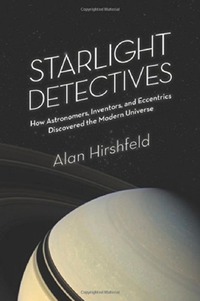Review: Starlight Detectivesby Jeff Foust
|
| “The classical astronomer’s question, ‘What is a star?’ evolved into the astrophysicist’s more profound inquiry, ‘What is a star?’” |
In the early 19th century, astronomers still used the same detector that they had for millennia: the human eye. The invention of the telescope two centuries earlier certainly helped astronomers see things they could not before, but they still relied on their eyes to see them, limiting how quantitative they could be. The invention of photography changed that: astronomers no longer had to rely on what their eyes could see (and imperfectly record) but instead create images that were both aesthetically dazzling as well as scientifically useful. Astronomers soon supplemented photography with another tool: spectroscopy, as that emerging technique moved from the laboratory to the observatory.
Telescopes, meanwhile, advanced and evolved during this era as well. Telescope designs changed as the camera, and not the human eye, became the primary tool used with them. The quest for more light to capture fainter objects drove the development of ever-larger telescopes, and a shift from refractors (still in wide use even in the late 19th century) to reflectors. By the early 20th century, Hirshfeld notes, the “era of modern megareflectors” began with the construction of 60- and 100-inch telescopes atop Mount Wilson in California.
These technological advances also had effects on astronomy as a discipline and institution. For much of the 19th century, amateur astronomers—without formal academic training, and in many cases with significant personal wealth they could spend on astronomy—played key roles in advancing the field, including many of the early innovations in astrophotography. By the end of the century, though, astronomers were largely shunted to the side as the field advanced. That was in part to the growing costs of state-of-the-art equipment needed to carry out research, as well as the growing academic rigor of what was becoming known as “astrophysics.”
Hirshfeld, a physics professor and astronomer, wonderfully describes this era of astronomical innovation in Starlight Detectives. The book is best described as a history of science and technology text: while he discusses the astronomical discoveries made throughout this era (which runs from the early 19th century though the 1920s), his focus is on the people and their efforts to advance the technology. He paints vivid portraits of the people, both professionals and amateurs, in Europe and the United States who drove that shift from basic observational astronomy to more advanced astrophysics. “The classical astronomer’s question, ‘What is a star?’ evolved into the astrophysicist’s more profound inquiry, ‘What is a star?’”
What technology taketh away can also, over time, giveth back. While advances in technology, and the expenses involved, pushed amateurs to the sidelines of astronomy around the end of the 19th century, they continue to play a major role: they are often the first to spot a new supernova or comet, for example. Indeed, the advances in technology, in electronics and detectors, can give a dedicated amateur capabilities that only professionals had access to a few decades ago. Even those without telescopes can participate: citizen science projects like Zooniverse allow those with only a computer and Internet connection to search for asteroids or classify galaxies in imagery. Today, almost anyone can be a starlight detective.
